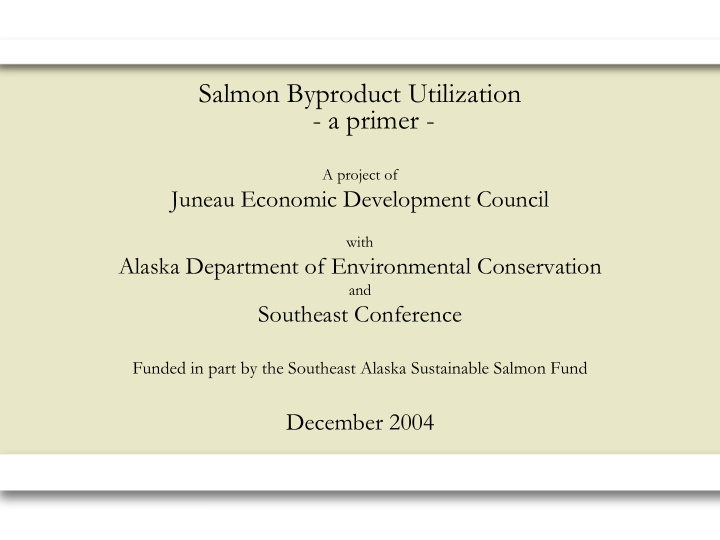



Salmon Byproduct Utilization - a primer - A project of Juneau Economic Development Council with Alaska Department of Environmental Conservation and Southeast Conference Funded in part by the Southeast Alaska Sustainable Salmon Fund December 2004 Salmon Byproduct Utilization
Strategy • find feasible alternatives to discarding of byproducts from seafood processing • focus on Southeast Alaska salmon • financed in part by Southeast Sustainable Salmon Fund • cooperators include: harvesters, processors, and other businesses Salmon Byproduct Utilization
Methods • investigate the entire value chain of use of byproducts, from simple discharge (dumping) to industrial uses to human consumption • possible uses include: fish meal, fish oil, hydrolysate, compost, nutraceuticals, and others • basic parameters include capital costs, gross production costs, seasonal considerations, variable capacity, and shipping costs • investigate markets for byproducts -- reports available at: www.jedc.org/salmon Salmon Byproduct Utilization
SE Alaska Salmon Harvests (10-year averages, all species) • 67.7 million fish • 311.7 million pounds, very variable • 84.3 million dollars, steadily declining but upwards trends in niche markets Salmon Byproduct Utilization
Southeast Alaska Salmon Harvests 450.0 400.0 350.0 300.0 250.0 200.0 150.0 100.0 50.0 0.0 1994 1995 1996 1997 1998 1999 2000 2001 2002 2003 y ear fish pounds dollars Salmon Byproduct Utilization
A Big Problem • ~70% of Alaska salmon leaves the state in canned or h&g form • ~50% of landed weight of salmon is used for human consumption • after the salmon is processed, ~50% of every fish is “waste”: heads, guts, low-value carcasses • > 150 million pounds of raw material is available for byproduct processing per year in Southeast Alaska • leaving 50% byproduct is fillet processing which is the preferable form of salmon in North America • standard practice: “grind-and-dump,” discarding this raw material into ocean Salmon Byproduct Utilization
Change Is Necessary • US Environmental Protection Agency requires decrease and/or elimination of discharges • US Magnuson-Stevens Act (1996) requires greater utilization of harvested resources • depressed markets for salmon meat provide new incentives for better use of resources • processors struggle to stay profitable, and continue to buy fishermen’s fish, while dealing with “waste” • any increase in profitability improves the economic health of the entire industry, which employs ~2,000 in SE Alaska Salmon Byproduct Utilization
Opportunity • environmental regulations and seafood economics force greater attention to byproduct utilization • growing uses for fish-based protein and other byproducts: feeds for animals & aquaculture, fertilizer, human consumption, nutraceuticals • growing demand for fish protein: demand will exceed supply by 2016 • Alaska can become competitive in global fish protein markets, and other byproduct-based markets Salmon Byproduct Utilization
Projected World Demand for Fish Protein -an opportunity for Alaska- 200 175 MILLION METRIC TON 150 125 100 75 50 25 0 1984 1989 1994 1999 2004 2009 2014 2019 2024 2029 Source: Fisheries of the United States 2001, FAO 2002 Edible Fish Available Demand Aquaculture Salmon Byproduct Utilization
Examples of Uses of Byproducts • basic products produced in Alaska now -- fish meal plants: Kodiak, Unalaska, Petersburg, Seward, Valdez (Bear & Wolf), Cordova, -- fish oil for fuel: at-sea whitefish processors -- composting with sawdust: Kake Foods -- protein hydrolysate: Alaska Protein Recovery • refined products produced in Alaska in future -- fish oils for feed & food additives -- nutraceuticals & cosmetics Salmon Byproduct Utilization
Byproduct Use Is Influenced by • raw material: species composition, protein & fat content, quantities available, seasonality, distance from plant • costs of operations: utilities, labor, capital equipment, freight • technology: types and capacities of machines • markets: for basic products (eg- liquid fish protein) or finished products (eg- aquaculture feed) Salmon Byproduct Utilization
Results and Project Contact Numerous reports addressing the economics, markets and methods of salmon byproduct utilization can be found on our website. Project Contact: Lance Miller, Executive Director Juneau Economic Development Council 612 West Willoughby Avenue, Suite A Juneau, Alaska 99801-1732 ph : 907-463-3662 fx : 907-463-3929 http://www.jedc.org/salmon/ lmiller@jedc.org Salmon Byproduct Utilization
Recommend
More recommend